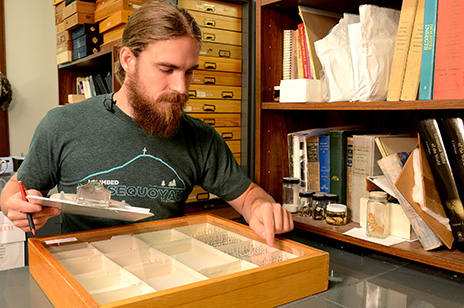'Bioblitz' Identifies Arthropod Museum's Holdings

Doctoral student Michael Skvarla tabulates specimens during a “bioblitz” held in the University of Arkansas Arthropod Museum. The research museum is maintained by the University of Arkansas System Division of Agriculture and contains some 750,000 specimens in its collection.
FAYETTEVILLE, Ark. — The third floor of the Agriculture Building on the University of Arkansas campus has a bug problem.
That is, it had a bug problem.
The Arthropod Museum, maintained by the University of Arkansas System Division of Agriculture, contains thousands of insect specimens — some 750,000 specimens, as it turns out. The problem was that, until this summer, no one knew for sure how many specimens were in the collection.
"We decided to hold a bioblitz to get an accurate count of what we had in the museum," said Robert Wiedenmann, head of the department of entomology.
A bioblitz, Wiedenmann said, is usually a concentrated survey of all species within a defined area, such as a park or nature preserve, conducted over a 24-hour period. The Arthropod Museum bioblitz was held over a four-day period with 26 faculty, staff and students from the entomology department, as well as a few interested individuals from outside the department.
The count took a total of 150 hours, Wiedenmann said. At the conclusion, the group had counted more than 400,000 pinned specimens, about half of which were identified to species, and more than 22,000 vials, each of which contained from one to many dozens of specimens.
Although the museum includes species found worldwide, Wiedenmann said most of the collection represents insects, spiders and other arthropods from Arkansas' interior highlands — the Ozark and Ouachita mountains.
The unique species found in the museum include a wood wasp that develops as larva in hardwood trees and is only seen in its adult form for 5 to 7 days a year. Another is a species of enamel green and blue small-headed fly, native only to the Ozarks highlands, that parasitizes tarantulas.
The Arthropod Museum is not what most people expect, Wiedenmann said. It's not a showy museum with big displays.
"This is a research museum," he said. "We use the collections to help identify insects submitted by Arkansas residents. Also, scientists worldwide use these specimens to help identify species they find in their field research."
Topics
Contacts
Fred Miller, Science Editor
Agricultural Communication Services
479-575-5647,
fmiller@uark.edu
Headlines
PetSmart CEO J.K. Symancyk to Speak at Walton College Commencement
J.K. Symancyk is an alumnus of the Sam M. Walton College of Business and serves on the Dean’s Executive Advisory Board.
Faulkner Center, Arkansas PBS Partner to Screen Documentary 'Gospel'
The Faulkner Performing Arts Center will host a screening of Gospel, a documentary exploring the origin of Black spirituality through sermon and song, in partnership with Arkansas PBS at 7:30 p.m. Thursday, May 2.
UAPD Officers Mills and Edwards Honored With New Roles
Veterans of the U of A Police Department, Matt Mills has been promoted to assistant chief, and Crandall Edwards has been promoted to administrative captain.
Community Design Center's Greenway Urbanism Project Wins LIV Hospitality Design Award
"Greenway Urbanism" is one of six urban strategies proposed under the Framework Plan for Cherokee Village, a project that received funding through an Our Town grant from the National Endowment for the Arts.
Spring Bike Drive Refurbishes Old Bikes for New Students
All donated bikes will be given to Pedal It Forward, a local nonprofit that will refurbish your bike and return it to the U of A campus to be gifted to a student in need. Hundreds of students have already benefited.




